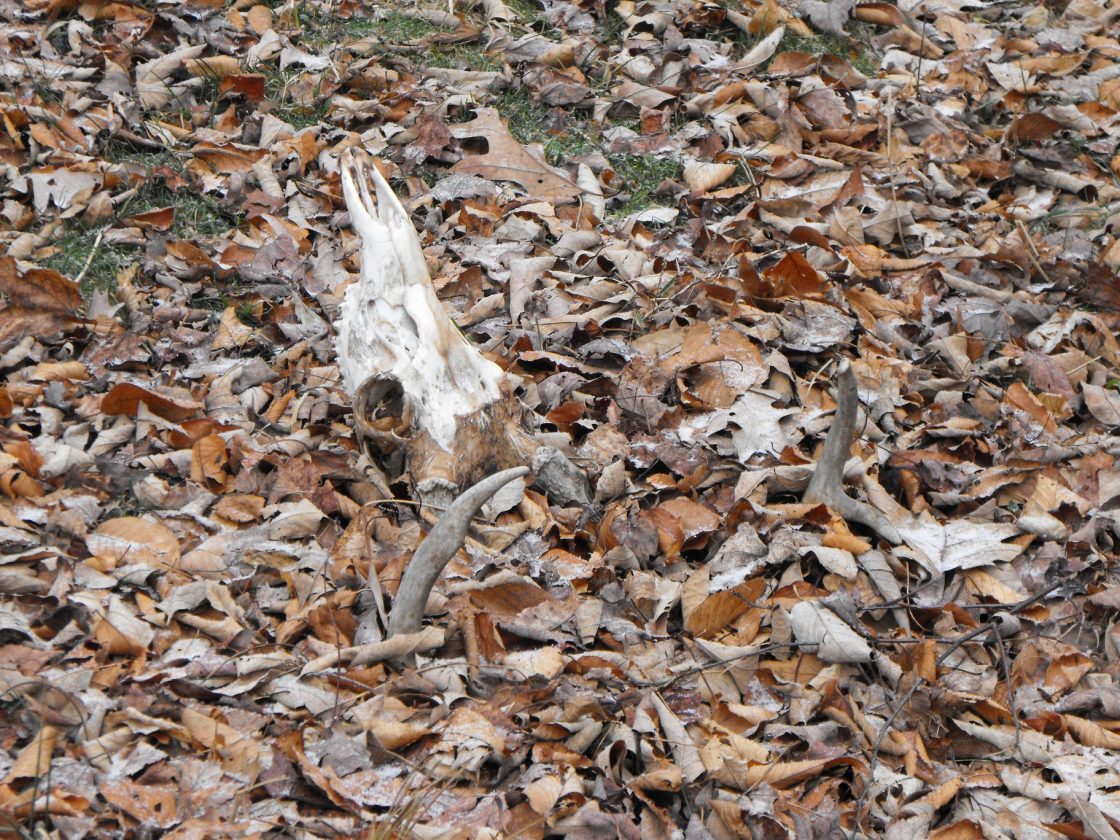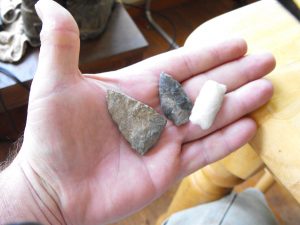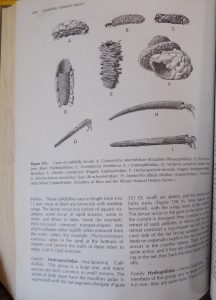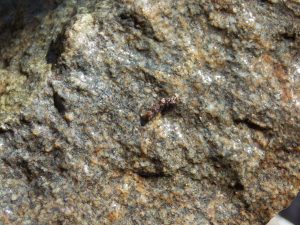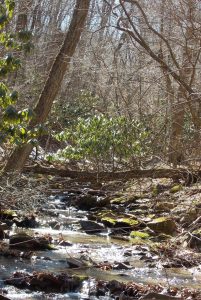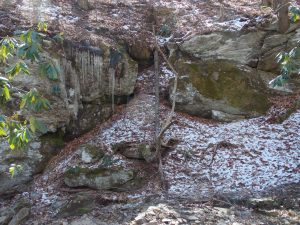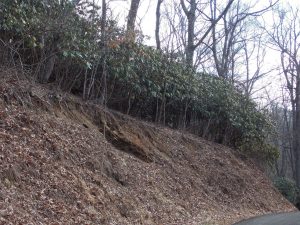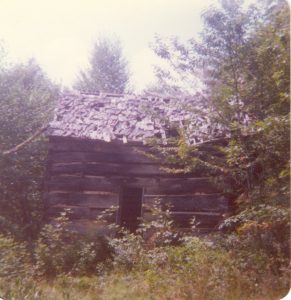Every year, usually during Spring turkey season, I set aside a day to climb Buck Mountain. I can easily drive up to the top but I make every effort to at least once during each spring to do it ‘on my hind legs’, and away from the road. It’s getting tougher every year—Father Time has a hand on my shoulder now and I have to take it slower than I did at 20; but that disappointment is mitigated in that I now, in taking my time, see and hear and feel much more than in my youth.
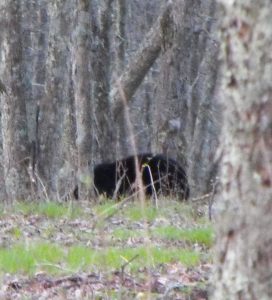 At good daylight I park beside the stock pond in the low boundary and here take the time to prospect a bit, searching the bare patches of ground and the gravel bars along the headwaters of Peach Bottom Creek. I do this as a prelude to my climb, to get the ‘kinks’ out, but also as my way of remembering the first folks on the Mountain, the Native Americans, who first camped and hunted here thousands of years ago, and their progeny that enjoyed this place until the 1700’s. Near the Locust Spring, the hand-hewn rock collection bowl next to an ancient locust tree, I find their tools and scraps of tool material, and try to imagine what sitting around the campfire with them would have been like. Those folks knew things I need to know; how to tell by the clouds and wind when the weather is about the change, where the morels grow the biggest, which tree bark is best for tanning hides or which plants will calm a sour stomach or nagging headache. Their biological clocks ran faster than ours do; most of them were dead by 40 and I don’t know how they crammed a life and all that it entails into that blink of an eye. They chose to live here for all the right reasons; wood, water, game, protection, beauty; no wonder they fought so hard to stay. I wonder how many are buried here, now part of the mountain. I wish I could have seen their mountain as they did; and smell their campfires and hear their children laugh. I’m lucky today and I pocket a couple good projectile points and a few chert chips. Please hold my place for me, by the hearth. I’ll be back.
At good daylight I park beside the stock pond in the low boundary and here take the time to prospect a bit, searching the bare patches of ground and the gravel bars along the headwaters of Peach Bottom Creek. I do this as a prelude to my climb, to get the ‘kinks’ out, but also as my way of remembering the first folks on the Mountain, the Native Americans, who first camped and hunted here thousands of years ago, and their progeny that enjoyed this place until the 1700’s. Near the Locust Spring, the hand-hewn rock collection bowl next to an ancient locust tree, I find their tools and scraps of tool material, and try to imagine what sitting around the campfire with them would have been like. Those folks knew things I need to know; how to tell by the clouds and wind when the weather is about the change, where the morels grow the biggest, which tree bark is best for tanning hides or which plants will calm a sour stomach or nagging headache. Their biological clocks ran faster than ours do; most of them were dead by 40 and I don’t know how they crammed a life and all that it entails into that blink of an eye. They chose to live here for all the right reasons; wood, water, game, protection, beauty; no wonder they fought so hard to stay. I wonder how many are buried here, now part of the mountain. I wish I could have seen their mountain as they did; and smell their campfires and hear their children laugh. I’m lucky today and I pocket a couple good projectile points and a few chert chips. Please hold my place for me, by the hearth. I’ll be back.
I’m going to follow the creek today; I haven’t done that in a while and want to see what kind of shape it is in. It will be a bit cooler along the creek and I can see that I picked the right day for my hike; it is warm for early April and the trees are just starting to bud, and they are filled with warblers and finches. At this low elevation the hellebore and skunk cabbage are poking green sprouts up through the dead leaves and it won’t be long until the ramps and mushrooms will join them, and those I will hunt with a smile. A panful of fried morels and ramps sounds pretty good right about now. I should have eaten more breakfast!
 I see the hump of duff where the Noah Johnson cabin once stood; the barn is still here but the cabin is long gone. On hunting trips to the Mountain in the 1970’s my friends and I camped in the place, it was a ruin even then, but the rock fireplace still worked and kept us warm even when you could see through the walls. It was too far gone to salvage but the wood beams in the Ball cabin, down another holler just up the mountain from here, were still in pretty good shape in those days, and my brother-in-law Alan Todd and I salvaged as much of the chestnut as we could. Forty years ago I made Cecelia’s engagement ring from a piece of chestnut from that cabin; that was the smartest thing I ever did.
I see the hump of duff where the Noah Johnson cabin once stood; the barn is still here but the cabin is long gone. On hunting trips to the Mountain in the 1970’s my friends and I camped in the place, it was a ruin even then, but the rock fireplace still worked and kept us warm even when you could see through the walls. It was too far gone to salvage but the wood beams in the Ball cabin, down another holler just up the mountain from here, were still in pretty good shape in those days, and my brother-in-law Alan Todd and I salvaged as much of the chestnut as we could. Forty years ago I made Cecelia’s engagement ring from a piece of chestnut from that cabin; that was the smartest thing I ever did.
Those settlers had to know things too; when to plant, how to cure meat and store vegetables, how to keep the spring running, how to gauge the weather for cutting hay and whose job was what. Everyone had a job on the homeplace; if you were old enough to walk you were old enough for learning to pitch in. We have lost a lot of that today. Do you know how to sharpen a knife, like my Granny did before she cut the slab bacon? Do you know how to make white oak splits or cedar shakes, or even what they are? What do you do when the children are sick and you can’t get to the doctor, what do you put on a bee sting to kill the pain and itch-and how do you encourage the bats and purple martins to stay around the house to eat the ‘skeeters? Do you know the best time to hit the river for the sucker run, or which hickory trees have the sweet early nuts for September squirrel hunting, and which are best for the November hunt? Folks seemed to be more in tune with the land and with each other just a few years ago; but I believe that those things we can get back.
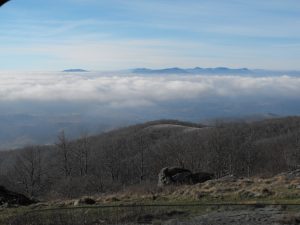 Just above the old tree house I find a winter casualty. The white bone draws my eye and I know what it is before I ever touch it. When the deer rut takes place bucks stop eating to chase does and they may lose up to 30% of their pre-rut body weight; if there is insufficient food post-rut, during the winter and early spring stress period, many succumb. Our region has suffered thirty years of chronic deer overpopulation and the signs are everywhere of this; probably the most visible is the rhododendron. This understory shrub is shade tolerant and its limbs and leaves should be at contact with the ground; it is also a starvation food for deer, and is even mildly toxic to them, but if there is nothing else, deer will eat it. I take a photo of the rhododendron around me: it has been browsed to shoulder level, not something that happens overnight; it took decades for this browse line to appear. The winter of 2009-2010 took care of the problem; we lost about 40% of our deer herd that winter and even though numbers were reduced, the damaged habitat could not recover. It can be a hard world.
Just above the old tree house I find a winter casualty. The white bone draws my eye and I know what it is before I ever touch it. When the deer rut takes place bucks stop eating to chase does and they may lose up to 30% of their pre-rut body weight; if there is insufficient food post-rut, during the winter and early spring stress period, many succumb. Our region has suffered thirty years of chronic deer overpopulation and the signs are everywhere of this; probably the most visible is the rhododendron. This understory shrub is shade tolerant and its limbs and leaves should be at contact with the ground; it is also a starvation food for deer, and is even mildly toxic to them, but if there is nothing else, deer will eat it. I take a photo of the rhododendron around me: it has been browsed to shoulder level, not something that happens overnight; it took decades for this browse line to appear. The winter of 2009-2010 took care of the problem; we lost about 40% of our deer herd that winter and even though numbers were reduced, the damaged habitat could not recover. It can be a hard world.
When I asked Mother’s cousin, Glen Pearman, why, when he cut the buckwheat, he left a wide strip along the fence, he told me “We always leave some for the game”. When he cut firewood he would pile the slash so the rabbits and quail would have a place to beat the fox and when they picked corn they did not begrudge a few ears for the ‘coons. Give thanks and give back, he told me. Where has that idea gone?
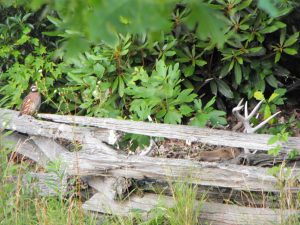 It occurs to me that the Mountain seems steeper now than it was when I was young, reminding me that as in life, the steps we have to take as time passes get taller. My walking stick tip disappears into the carpet of spring beauties (Claytonia virginica) at my feet, looking for all the world like a dusting of snow on the ground under the big timber around me. This is the first real sign of spring on the Mountain, a telling that the clock is ticking and life goes on—the cycle of moons and seasons that mark mountain time. I find that concept comforting; I remember the phrase “life everlasting, world without end”.
It occurs to me that the Mountain seems steeper now than it was when I was young, reminding me that as in life, the steps we have to take as time passes get taller. My walking stick tip disappears into the carpet of spring beauties (Claytonia virginica) at my feet, looking for all the world like a dusting of snow on the ground under the big timber around me. This is the first real sign of spring on the Mountain, a telling that the clock is ticking and life goes on—the cycle of moons and seasons that mark mountain time. I find that concept comforting; I remember the phrase “life everlasting, world without end”.
The creek is a seep now, up here in the cove below the Buzzard Rock, and I roll a few rocks to check on the aquatic insect population. Stonefly and Mayfly larvae, and the Caddis cases with the caddis larvae hiding in them greet me, along with salamanders and tiny crayfish. Predators all, in a microscopic world upon which mountain life was built. I turn my head at an out-of-place sound and find I am not alone in my rock rolling; a fair-sized black bear is also about his business, digging beechdrop and prospecting for a snack. His myopia is my friend and I am downwind of him, so he ignores me, shuffling around in the broken rock and big timber, his steps making a sucking sound in the mud. What a treat to see him; we forget that while we occupy ourselves with ‘important’ things, the mountain goes on living. I can hear life humming around me.
On top the vista opens up. Ridge after ridge, like timbered blue waves on the ocean, disappear in the haze. I can see the river from here, and try to ignore the few houses I see. The air is just sweet. Off in the distance a wild turkey gobbles.
That is what I call a successful hunt.
POSTSCRIPT:
For those of you who wish to know about the spring turkey hunting addiction, last year I published a turkey hunt story in Shotgun Life, an on-line magazine, that may help explain it. If you have interest, you may find it at the link below. It is not politically correct. But it is honest, and you might like the photos.
http://www.shotgunlife.com/…/wingsh…/the-hell-hole-bird.html

